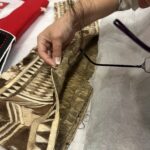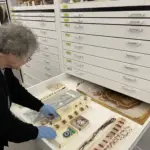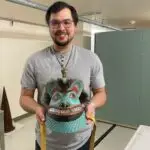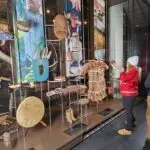Storyknife Writers Retreat
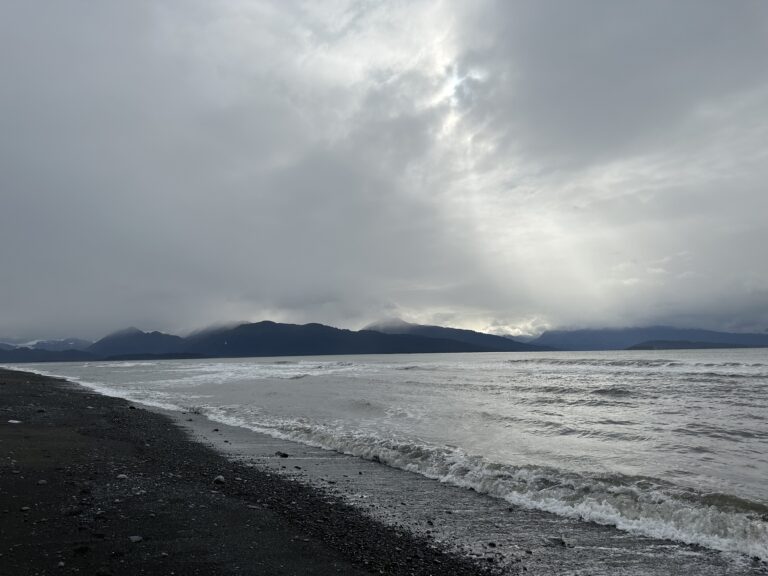
In October, 2023 I attended a two-week writing residency at Storyknife. This residency was made possible through the generous support of the Alaska Native Art and Culture Writing Fellowship sponsored by The CIRI Foundation.
The day before I traveled, I submitted my dissertation, On felt structures: weather, embodiment, and materiality, to Queen’s University’s digital repository. I am Sugpiaq from Ag’waneq and Masiqsiraq (the Native Villages of Afognak and Port Lions). I make performances, videos, installations, and writing. The dissertation addresses Sugpiaq histories and provides a context for my artmaking. My mind was tired after writing in and through the pandemic. While I felt encouraged by and kept buoyant by my family, I also felt partially spent.
On the flight to Anchorage I listened to Elisapie’s album, Inuktitut. An Inuk singer/songwriter based in Montréal, the cover album is sung in her mother tongue. I repeatedly listened to “Sinnatuumait (Dreams),” “Uumamati Attanarsimat (Heart of Glass),” “Isumagijunnaitaungituq (The Unforgiven),” and “Qimmijuat (Wild Horses)”—the sound of Inuktitut shifting my experience of these rock, new wave, disco, pop and heavy metal ballads.
When I arrived at the Homer Airport on a RAVN flight, I felt energized to be in the lands of Nichiłt’ana, Ninilchik Village Tribe, Dena’ina and Sugpiaq lands. While I hadn’t visited Homer since my childhood when we caught the ferry from Kodiak to the mainland, my cousins had moved to the fishing town decades ago. As we drove from the airport to Storyknife, we were told that the sandhill cranes departed just before our arrival. I sensed that my time in this place would bring about restoration and generate writing.
Staying in the small cabin named after Katie Kashevaroff (Unangan) reminded me of living with my parents in our village; our family home is situated on a peninsula with views to the water on either side. The quiet in both places is calming. I shared the cabin with a stunning painting of red forms by Athabascan and Inupiaq artist, Sonya Kelliher-Combs. This felt like good luck as I intended to write for Sonya Kelliher-Combs’ forthcoming art catalogue, Mark (published by Hirmer), during the residency.
I looked out the window watching the sun and clouds move through the sky. On clear days, I looked towards the Kenai and Chigmit mountain ranges and especially the three nearby volcanoes, including Iliamna. I felt deeply moved by dusk and sunsets. I practiced gentle movement. I walked along dirt roads alone and with the other writers. The grasses, alders, and fireweed were turning colour as the chill of autumn seeped into our evenings and then days. I drank tea to warm myself. I shared many meals with extraordinary women writers. Their stories sparked laughter and kept me rapt. Our time at Storyknife was nourishing due in part to the incredible staff. I allowed myself to rest and recover.
I spent an afternoon watching the waters of Kachemak Bay crest then fall to the sandy, stone-filled beaches near the spit, not far from Old Town. Another afternoon I climbed down bluffs along Diamond Creek to look at stones, driftwood, kelp, and waves. My friend and I hiked the steep, muddy trail, visiting along the way.
The first snowfall of the season happened. Abundant, it eventually melted before my departure.
I continued to listen to Elisapie’s songs in Inuktitut and albums by the British collective, Sault. Influenced by soul, funk, jazz, house, punk, gospel and disco, Sault’s songs are sometimes political responding to police violence against Black folks. Elisapie’s album addresses childhood memories, including mourning young relatives. Music responds to the moments that we are in and may give us strength to continue in the midst of injustice and grief. Writing also has the capacity to do this.
Sonya Kelliher-Combs’ painting hovered above the writing desk. I remembered my experiences of her paintings and sculptures over many years in museums. Sonya often cites Alaska Native women’s sewing processes and uses of materials such as gut in her art works. I thought about gut and its capacity to swell with water and brittle with aridity. I thought about our grandmothers; their actions kept us warm and dry in stormy weather; their devotion kept us cherished in the midst of deeply unjust histories.
Near the end of the residency, I ate fresh king salmon and scallops with my cousins and auntie.
As I said goodbye to the community of women writers, traveled to the airport and waited for my flight, a solar eclipse happened.
I left Storyknife with another draft of writing. Not yet fully renewed but grateful for my time to be in Denai’na and Sugpiaq lands in falltime; thankful to rest and to write.
Read more about TCF’s A Journey to What Matters: Increased Alaska Native Art & Culture
Seal Skin Design
Add Your Heading Text Here A Journey to What Matters:...
Read MoreMuseums Alaska – Alaska State Museum Visit
A Journey to What Matters: Increased Alaska Native Art &...
Read MoreShare Your Story: ANC Museum Archives
A Journey to What Matters: Increased Alaska Native Art &...
Read MoreKodiak Alutiiq Dancers AANC Anchorage Museum
A Journey to What Matters: Increased Alaska Native Art &...
Read More
